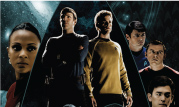KAIJU! RON PERLMAN ON PACIFIC RIM
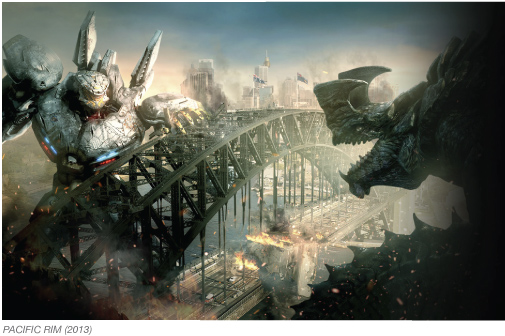 "I'm trying to honor the traditions of manga, mecha and kaiju films," director Guillermo del Toro says respectfully on the Japanese trailer for PACIFIC RIM. The Warner Bros. summer tent pole movie arrives in theaters later this month, and one may wonder: Will a Japanese glossary be handed out with the 3-D glasses?
"I'm trying to honor the traditions of manga, mecha and kaiju films," director Guillermo del Toro says respectfully on the Japanese trailer for PACIFIC RIM. The Warner Bros. summer tent pole movie arrives in theaters later this month, and one may wonder: Will a Japanese glossary be handed out with the 3-D glasses?
We asked Ron Perlman, who plays Hannibal Chau in the film, to clue us in. He hadn't encountered the word kaiju – Japanese for "strange beast," aka giant monsters – before the script arrived, but he did recall seeing the granddaddy of the kaiju film genre, GODZILLA, on television in the 1950s.
That's when Kaiju caught on as a city-smashing symbol of the nuclear threat. GODZILLA (1954) ravages Tokyo within a decade of the atomic bombs' destruction of Hiroshima and Nagasaki. The lizard-like monster comes to life as the result of fallout from nuclear weapons testing in the Pacific. The existence of RODAN (1956), a pre-historic and supersonic "pteranodon," is likewise blamed on radioactive rainwater, which causes mutations in the beast's buried eggs.
"I knew GODZILLA and RODAN, but I didn't know they were kaiju," said Perlman. "Those were the first movies I was watching as a little tyke growing up in Washington Heights [in upper Manhattan]. Remember MILLION DOLLAR MOVIE? It played one movie a week...twice a night at 7:30 and 9:30, so if you missed one, you'd catch it again. And whoever did the programming for that covered the waterfront."
Years later, del Toro, with whom Perlman has now worked on five films including the HELLBOY series, introduced the actor to manga, a centuries-old tradition of Japanese comic books, through Perlman's son Brandon. "Guillermo's almost like a family member. My kids call him Uncle Billy. He turned Brandon onto manga and [Hayao] Miyazaki [a Japanese film director, animator, manga artist, producer and screenwriter.] Most of my son's childhood was formed by this unbelievable fascination with Japanese culture."
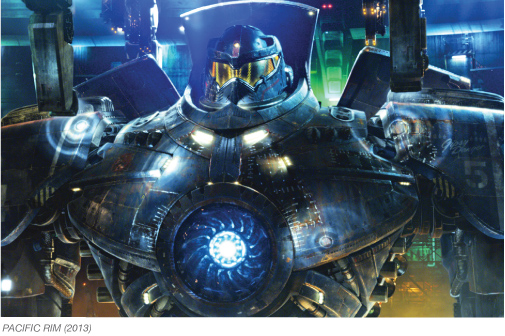
In the 1960s, the kaiju genre grew as King Kong, the big ape from an earlier filmmaking era, came back to fight the new kaiju on the block in KING KONG VS. GODZILLA (1962). In the film's ambiguous conclusion, Kong swims away while Godzilla sinks beneath the waves. Another heavyweight match pitted Mothra, a giant female moth/butterfly/thing, against the former champ in MOTHRA VS. GODZILLA (1964). GAMERA (1965), a fire-breathing flying turtle, faced new competition from a gigantic bat ejected from a volcano in GAMERA VS. GYAOS (1967) as combinations of kaiju began to dominate the genre. In DESTROY ALL MONSTERS (1968), when a group of alien women took control of an army consisting of Godzilla, Rodan, Mothra, Angilas (a 50 kiloton ankylosaurus) and Minya (Godzilla, Jr.) in an attempt to crush every city on earth, the genre seemed to have played itself out, and Kaiju found a new home in television and video games.
With few exceptions, behemoths remained dormant as a feature film genre for a generation, or until 1991 when GODZILLA VS. KING GHIDORAH, which showcased a three-headed dragon, re-emerged from the cinematic deep, quickly followed by several other Japanese productions. American studios returned to the form in 1998 when Roland Emmerich's GODZILLA shed the man-in-monster-suit look and digitally destroyed most of Manhattan. Ten years later, Matt Reeves' CLOVERFIELD took a handheld video approach to its story of a frightened newborn kaiju throwing a temper tantrum in New York Harbor.
RECOMMENDED BY AFI
Can't get enough of giant monsters gone wild? Continue your rampage through the cinematic history of genre-juggernauts with these three unstoppable classics.

KING KONG (1933) – Brought to life by groundbreaking, painstaking stop-motion effects, KING KONG is far more than simply a story of a great ape run amok. An undeniable classic, it's a tragic tale of beauty and a beast – the latter lured from his jungle dominion and reduced to a sideshow oddity by the film's true monsters.

GOJIRA/GODZILLA (1954) – Monster Zero of the kaiju genre is the great GOJIRA – the must-see Japanese classic known to American audiences as GODZILLA. Everything about it has become iconic – the Tokyo rampage, the creature's signature screech, the man-in-suit effects aesthetic – and the original GOJIRA/GODZILLA still towers over its countless sequels, spin-offs, remakes and imitators.

ALIENS (1986) – This sci-fi classic from director James Cameron pits monster against mecha in its iconic climax – a grudge match between the gruesome alien queen and Ripley's robotic power loader. What the face-off lacks in scale (comparable to Kong and Godzilla, anyway), it more than makes up for in female fury.
Now it's PACIFIC RIM's turn. But rather than have a pair of computer generated kaiju battling it out, del Toro's film has multiple kaiju going up against another staple of modern science fiction – mecha. Japanese shorthand for "mechanical," the term refers to all mechanical objects, including the kind of XXL robots with limbs first conceived by Jules Verne in his 1880 novel "The Steam House," which featured a piloted mechanical elephant. The tripods in H.G. Wells "The War of the Worlds" are another example from literature. Moviegoers in Japan remember Mitsu Yokoyama's TETSUJIN 28-GO (1956), which first introduced a giant robot and Go Nagai's TV series MAZINGER Z, which firmly established the mecha genre. American audiences joined the fun when massive Imperial AT-AT Walkers trudged across the screen in George Lucas' STAR WARS: EPISODE V – THE EMPIRE STRIKES BACK (1980).
In PACIFIC RIM, the mecha are called "Jaegers" (pronounced yay-gurs). "The Jaegers are created because no one knows what to do about the kaiju," Perlman explained. "This rift opens up in the core of the earth and these kaiju begin appearing in vast numbers, and they're unstoppable. They're big. They're unwieldy. They have infinite power. And they're ruthless in nature. They pose a real threat to the future of mankind." How big are the Jaegers? In the PACIFIC RIM trailer, we see one clobber a kaiju wielding an oil tanker like a baseball bat.
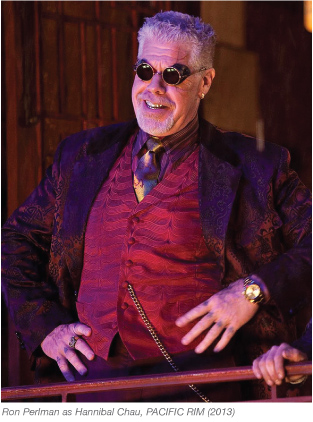
According to Perlman, "There are tent pole movies and then there are Guillermo del Toro movies. He adds these little idiosyncratic human touches to them that separate them from your typical result-oriented, one-dimensional, rock 'em-sock 'em tent pole movies."
Case in point: It takes two humans to operate a Jaeger from the inside. "When one of them does this," Perlman said, throwing a roundhouse right, "the robot punches. There is this humanity colliding with this mythic, indomitable force. And the humanity starts winning and turning the tide against this invasion until...they begin adapting. They say, 'okay, well, you got this, so we're going to turn into this.' And that's the movie," said Perlman.
Both sides in this titanic struggle need to adapt, which introduces what Perlman calls "one of the more poetic and compelling concepts in the movie" – that of "drift – where the brains of these two humans begin to intersect with one another to the point where one is starting a sentence and the other is ending it, or one knows what the other is going to do before they even know it themselves."
The drift connection between a pair of Jaeger operators sounds a bit like Perlman's sympatico with director del Toro. The two forged their relationship on CRONOS (1993), an independent feature made in Mexico. Perlman was impressed by the fierce commitment to artistic excellence of del Toro and his loyal crew. "These were the most honorable people I had ever met in my life," he said.
Perlman describes his PACIFIC RIM character Hannibal Chau as a war profiteer. "He's a black marketer. He's a guy who has no moral compass whatsoever. He benefits off of other people's misfortune and, in his obsession to just make as much money as is humanly possible, he's fashioned a relationship with the government whereby he owns the rights to the fallen kaiju, and he harvests the fallen kaiju for a variety of purposes. Kaiju bone powder happens to be 175 times more effective than Viagra, and kaiju glands will take an 80-year-old woman and make her look 36. So Hannibal's got the market cornered on this stuff. And, in so doing, he's got this stockpile of kaiju parts. For him, it's commerce. But for the scientist who is trying to figure out how to get the upper hand on the next evolution of the kaiju, Hannibal holds the key."
Hannibal seems to embody the PACIFIC RIM director's larger-than-life vision for his film, and Perlman credits del Toro with helping him find the character. "By the time they got to filming Hannibal's scenes they were already about 80 percent done with the filming of the whole movie... I went to this costume fitting and I ended up walking out looking like this croupier from Vegas on acid with these shades and this kind of red brocade vest, this white Jewish version of Sly and the Family Stone, including the gold teeth and gold shoes – like 24-carat gold shoes. And that was my first clue of how Guillermo thought of Hannibal. So I walk on the set, he goes: 'Perfect, we don't need to do anything, we're going to start shooting.' And whatever I did in the playing of the first scene, which happened to be one of the harder, more epic scenes we had to shoot, he wanted more. And I was afraid that I was going too far. But no matter how far I went, he wanted more. And so, in the execution of that 12-hour day, I came to understand what his version of Hannibal Chau was...This guy was like Jack Warner and Ringling Bros. rolled into one. He is a showman and he is a pirate and he has zero scruples, but a ton of personality. He was a joy to play because he's so deliciously immoral, but brilliant. Anybody who's that successful doesn't get that way by being stupid."
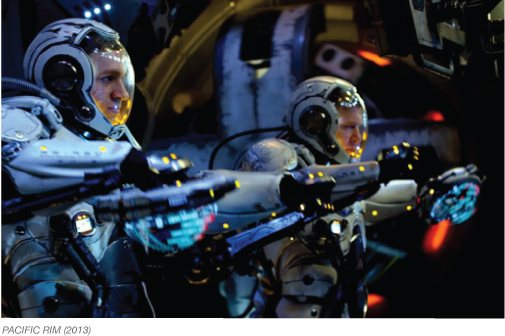 Perlman, a commanding actor with a deep voice and a twinkle in his baby blue eyes, has enjoyed a singular film and television career, beginning with a turn as a prehistoric tribesman in QUEST FOR FIRE and including such nontraditional roles as the hunchback Salvatore in THE NAME OF THE ROSE, the beast in TV'S BEAUTY AND THE BEAST, the title red demon in the HELLBOY series and, more recently, biker Clay Morrow in the FX Network series SONS OF ANARCHY. It is doubtful that any other actor has a more introspective take on movie monsters.
Perlman, a commanding actor with a deep voice and a twinkle in his baby blue eyes, has enjoyed a singular film and television career, beginning with a turn as a prehistoric tribesman in QUEST FOR FIRE and including such nontraditional roles as the hunchback Salvatore in THE NAME OF THE ROSE, the beast in TV'S BEAUTY AND THE BEAST, the title red demon in the HELLBOY series and, more recently, biker Clay Morrow in the FX Network series SONS OF ANARCHY. It is doubtful that any other actor has a more introspective take on movie monsters.
"In my recollection of my childhood, amidst the frustration and the pain and the feeling that the nose didn't quite match the forehead, didn't quite match the chin – you know, I never had a particularly high self – what's the word? – but this make-believe world that I got into by watching movies was truly transforming and transcendent and probably provided the greatest platform of discussion with my friends that I had as a kid growing up," said Perlman. "I didn't realize the power that this had over me – it was kind of a mystical power because, you know, where do these movies come from? Who made them? All I knew was that they were on the screen in my living room! Now that I've had 40 years in the business and I've looked at it from the other side, my appreciation for the art form has grown."
"There were guys back in the beginning of the art form who were famous for [playing monsters] – Lon Chaney, Boris Karloff," Perlman reminded us. "Clearly, there's a fascination with things that are powerful and explosively unpredictable and that we don't have any control over. And it's become a part of our storytelling in a way that's almost like parables. Our myths are filled with these creatures that are metaphors for something inside of us that we can't define or harness. Bringing those things to life is something that literature can do and that theater can do and that art can do, but nobody does it better than cinema because you can really bring it to life and you can create things as vast as your imagination...That thing I'm describing has got Guillermo del Toro fully in its grasp," Perlman observed.
Perlman has seen most of PACIFIC RIM. "It's the first time I've ever seen that much humanity interconnected with that much technology. Even the robots and the kaiju seem to truly exist in real time because Guillermo humanizes them and adds vulnerability – all the things that make humans fascinating are on the screen. I was blown away by how brilliant my friend is!"
PACIFIC RIM, which stars Idris Elba, Charlie Day and Charlie Hunnam, Perlman's co-star in SONS OF ANARCHY, opens July 12.
|
|
|
|
|



